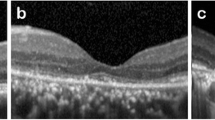Abstract
Background
Fundus autofluorescence is already used to evaluate inflammatory disorders affecting the chorioretinal interface. We investigated the autofluorescence characteristics of two cases of serpiginous choroiditis (SC) during recurrent acute episodes, and followed them until their resolution. We compared the autofluorescence findings with those obtained with other imaging techniques.
Methods
Autofluorescence photographs of the eyes were taken in a 26-year-old female and a 68-year-old male with SC at the first appearance of active lesions and during a strict follow-up period. Patients had complete ophthalmological evaluations including optical coherence tomography (OCT) and fluorescein and indocyanine green (ICG) angiography. Autofluorescence findings were compared with features from other imaging techniques. Patients were treated with systemic or intravitreal steroids.
Results
Hyperautofluorescence was detected 2 to 5 days after the appearance of the lesions, providing a clear delineation of the area of definitive retinal pigment epithelium (RPE) damage. This area was less extensive than the perfusion defect of the choriocapillaris indicated by ICG angiography. OCT showed very early increased reflectance of the photoreceptor layer in the area of hyperautofluorescence. A progressive decrease in autofluorescence was seen during the scarring phase of the disease. OCT changes in the photoreceptor layer were still present in the atrophic hypoautofluorescent lesions.
Conclusion
Fundus autofluorescence seems to be a very sensitive imaging technique for detecting damage of the RPE in acute episodes of SC. A sequence of autofluorescence changes reflects the passage from activation to resolution of new lesions. Similarities, but also differences can be found by comparing our SC findings with those obtained with autofluorescence and OCT in posterior multifocal placoid pigment epitheliopathy.




Similar content being viewed by others

References
Gass JDM (1997) Stereoscopic atlas of the macular diseases, diagnosis and treatment, vol. 1, 4th edn. Mosby, St. Louis, pp 49–286
Lim WK, Buggage RR, Nussenblatt RB (2005) Serpiginous choroiditis. Surv Ophthalmol 50:231–244. doi:10.1016/j.survophthal.2005.02.010
Giovannini A, Ripa E, Scassellati-Sforzolini B, Ciardella A, Tom D, Yannuzzi L (1996) Indocyanine green angiography in serpiginous choroidopathy. Eur J Ophthalmol 6:299–306
van Velthoven MEJ, Ongkosuwito JV, Verbraak FD, Schlingemann RO, de Smet MD (2006) Combined en-face optical coherence tomography and confocal ophthalmoscopy findings in active multifocal and serpiginous chorioretinitis. Am J Ophthalmol 141:972–975. doi:10.1016/j.ajo.2005.12.050
von Rückmann A, Fizke FW, Bird AC (1995) Distribution of fundus-autofluorescence with a scanning laser ophthalmoscope. Br J Ophthalmol 79:407–412. doi:10.1136/bjo.79.5.407
Spaide RF (2003) Fundus autofluorescence and age-related macular degeneration. Ophthalmology 110:392–399. doi:10.1016/S0161-6420(02)01756-6
Spaide RF (2006) Autofluorescence imaging of acute posterior multifocal placoid pigment epitheliopathy. Retina 26:479–482. doi:10.1097/00006982-200604000-00020
Souka AAR, Hillenkamp J, Gora F, Gabel V, Framme C (2006) Correlation between optical coherence tomography and autofluorescence in acute posterior multifocal placoid pigment epitheliopathy. Graefes Arch Clin Exp Ophthalmol 244:1219–1223. doi:10.1007/s00417-006–0343-1
Haen SP, Spaide RF (2008) Fundus autofluorescence in multifocal choroiditis and panuveitis. Am J Ophthalmol 145:847–853. doi:10.1016/j.ajo.2008.01.008
Quillen DA, Davis JB, Gottlieb JL, Blodi BA, Callanan DG, Chang TS et al (2004) The white dot syndromes. Am J Ophthalmol 137:538–550. doi:10.1016/j.ajo.2004.01.053
Author information
Authors and Affiliations
Corresponding author
Additional information
Supported by the Fondazione per la Macula Onlus, Genova, Italy.
The authors have no proprietary interest in any aspect of this report. The authors have full control of all primary data, and they agree to allow Graefe’s Archive for Clinical anf experimental Ophthalmology to review their data upon request.
Rights and permissions
About this article
Cite this article
Cardillo Piccolino, F., Grosso, A. & Savini, E. Fundus autofluorescence in serpiginous choroiditis. Graefes Arch Clin Exp Ophthalmol 247, 179–185 (2009). https://doi.org/10.1007/s00417-008-0951-z
Received:
Revised:
Accepted:
Published:
Issue Date:
DOI: https://doi.org/10.1007/s00417-008-0951-z



